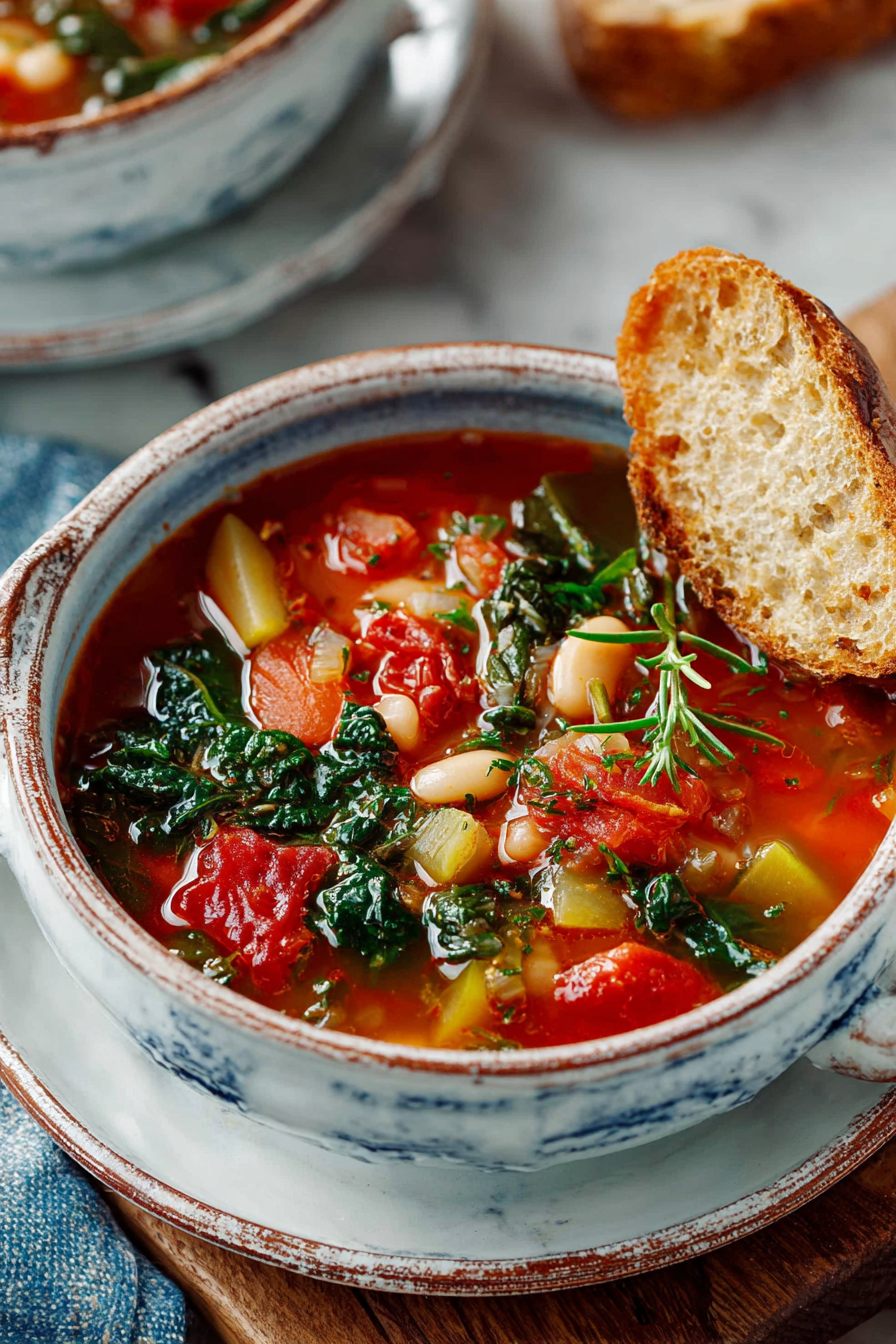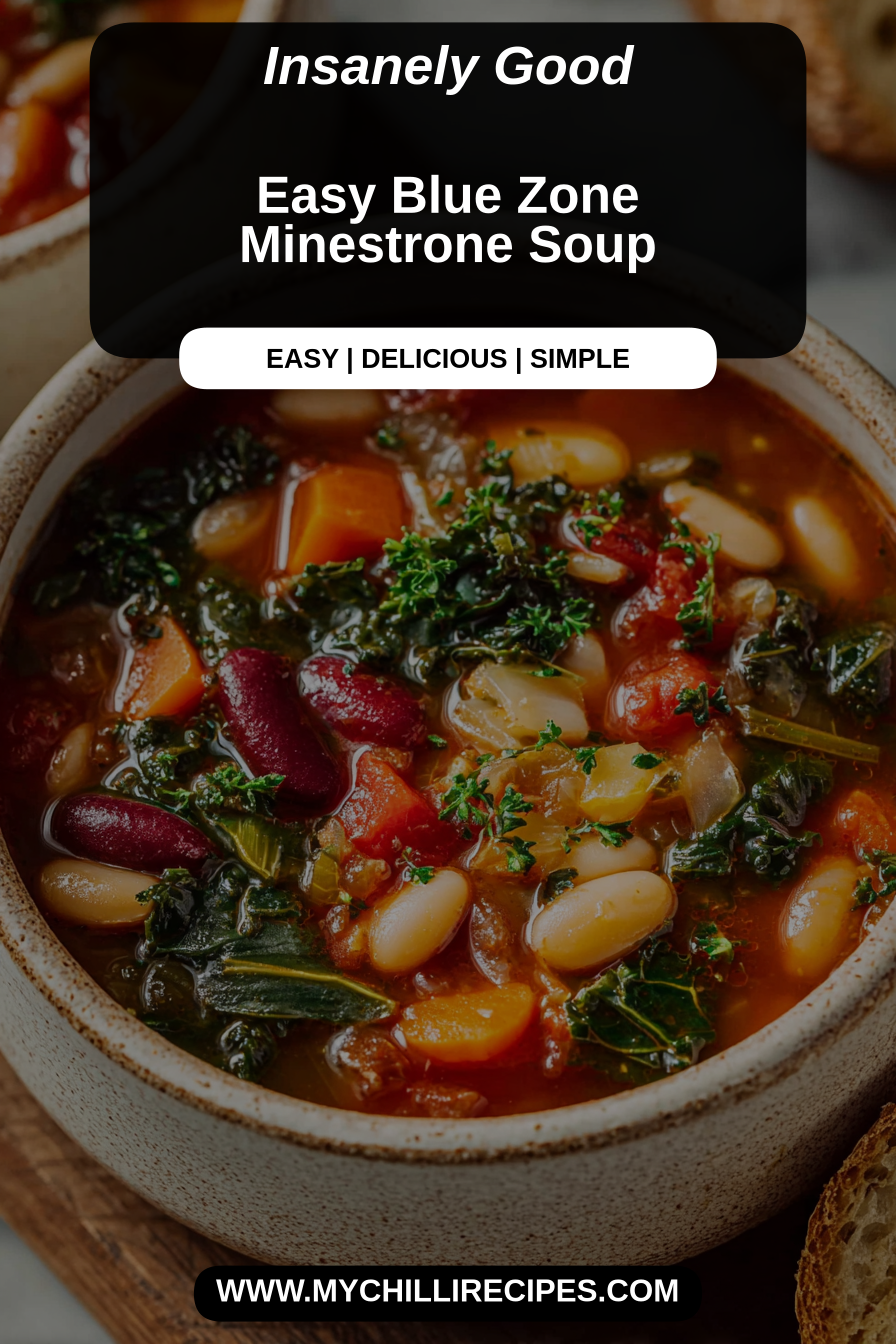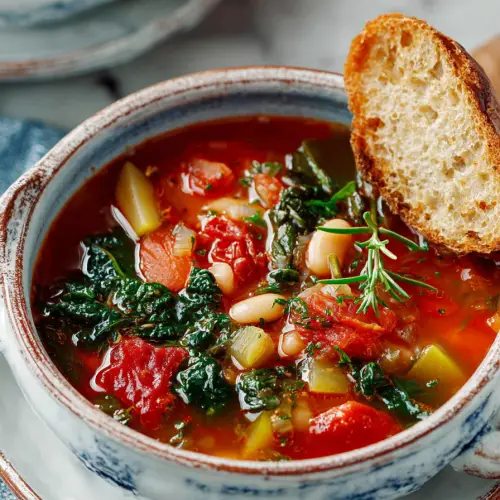Easy Blue Zone Minestrone Soup

There’s a quiet kind of comfort that arrives with a steaming bowl and a wooden spoon, and that’s exactly what this Easy Blue Zone Minestrone Soup offers. It’s not flashy—just honest vegetables, a soft chorus of herbs, and gentle broth that smells like a rainy morning at home. What makes it feel special isn’t a single thing; it’s the way the colors settle together, the soft bite of tender beans, and the warmth that lingers on your fingertips as you hold the bowl. I make it when I want something kind for my family and for myself—something that says, “take your time, you’re safe here,” and then proves it with every spoonful.
My husband has this habit of coming into the kitchen the second the onion hits the pan, like a moth to a porch light. Our youngest will often burst through the back door with a backpack still pinging little toys on the way in, asking if there’s soup for dinner. The dog parks his elbows on the cabinet and eyes the steam as if it might float a meatball right into his mouth. I’ll admit, the first time I tried this combination it wasn’t graceful—there was an over-enthusiastic pinch of salt and one pan that ended up a little too brown—but we learned together. Now, on slow weekend evenings, we gather bowls, laugh over small kitchen mishaps, and eat while the late light makes the soup shimmer, the sound of spoons and conversation folding into the evening.
MORE OF OUR FAVORITE…
Why You’ll Love This Easy Blue Zone Minestrone Soup
– It feels like a warm invitation: the aroma is soft and herbal, with a low, bright note—think sun-warmed tomatoes and a whisper of garlic—that settles into something very familiar and reassuring.
– Texture plays kindly here: silky beans, al dente vegetables, and tiny pops from whatever grain or pasta you prefer. Each spoonful is a small, happy surprise.
– It’s quiet comfort food that’s also lively—fresh herbs and a squeeze of lemon lift the broth so it never feels heavy, just deeply satisfying.
– Family-friendly and flexible: kids love the slurpy warmth, adults appreciate the balance, and it keeps well for lunches that feel like a hug in a container.
– Low fuss, high return: whether you’re making this for a lone, cozy night with a half-drunk cup of coffee or for a table full of stories, it’s reliably lovely.
Slow Moments
There are little rituals that make the soup feel like more than just dinner. I like to stand by the stove with a mug that’s gone tepid—too distracted for hot coffee—and stir slowly, listening to the soft tick as a lentil or two remind me they’re not quite done. Music is on low, something with piano and a slow beat, and the afternoon light leans through the window, splashing yellow across the counter. Someone will inevitably bound through, dropping shoes and leaving a trail of joy, and I’ll pass a spoon for a taste-test that becomes dinner. I love that pause between adding the herbs and lifting the lid—a moment of small trust, where a breath and a patient simmer do most of the work. Honestly, those are my favorite parts: the waiting, the little adjustments, the slow reveal when you taste and everything clicks into place.
Time-Saving Hacks
– Keep a jar of mixed dried herbs (oregano, thyme, bay leaf) ready so you don’t have to measure every time—one scoop saves a lot of mental energy.
– Use pre-cooked beans or a good-quality canned variety when evenings are busy; drain and rinse, then fold them in near the end to warm through.
– Chop vegetables the night before if you like a calmer morning; a covered bowl in the fridge keeps them bright and ready.
– Frozen greens are a gentle shortcut—toss them in at the last few minutes and they unfurl into the broth without any fuss.
– A calm reminder: if you slow down for the last five minutes to taste and adjust, the soup will repay you tenfold. Sometimes slowing is actually the time-saver because you avoid salvaging a dish later.
Serving Ideas
– For a simple weeknight, ladle into bowls and offer grated cheese, a drizzle of olive oil, and crusty bread for dipping—the kind you tear with your hands, crumbs and all.
– On a slower weekend, make a big salad with crunchy fennel and citrus, or roast a tray of seasonal root vegetables as a side. The contrast of warm soup and a crisp, cool salad is quietly celebratory.
– For breakfasts that feel a bit indulgent, I’ve found leftover minestrone beside a soft-boiled egg is unexpectedly lovely—salt and pepper, a gentle spoonful, and you’re set.
– Pair with a light, herbal tea or a glass of crisp white wine on evenings that demand a little extra calm.
– If you want something simple to serve alongside, warmed focaccia or garlic-smeared flatbread always disappears the fastest.
Tips & Mistakes
I once burned garlic because I was halfway through a conversation and forgot the stove was on; we ate the soup anyway after fishing out the charred bits, but the memory of that smell lingers. Now I set a timer or move the pan off the heat when I get distracted. Another small mistake I made early on was overcooking the vegetables—now I aim for gentle simmering and add delicate items late. Taste as you go, and don’t be afraid to add a splash of acid (lemon or vinegar) at the end to brighten things up. If you find the broth flat, a pinch of salt and a squeeze of citrus will usually rescue it. Be kind to yourself; soup forgives, and most mishaps become a story we laugh about later.
Storage Tips
Leftovers are a little miracle. I keep the soup in glass containers and find it tastes even better the next day—the flavors have had a small, sweet meeting overnight. Reheat gently on the stove with a splash of water or broth if it seems thick; a simmer is kinder than a boil. It freezes beautifully too, but if you plan to freeze, wait to add any tender greens or pasta; those are best added fresh when you reheat. Cold, it’s not my go-to breakfast, but a small bowl at lunchtime with a warm roll feels like a cozy pause in the day. Label and date your containers—the fridge may be forgiving, but a gentle, organized shelf brings peace in busy weeks.
Variations and Substitutions
I’ve tried this soup with different grains—barley adds chew, small pasta turns it into a spoonable hug, and farro brings a nutty depth that feels seasonal. For a lighter version, use more broth and fewer beans; for heartier, simmer in a handful of cubed winter squash. Fresh herbs in summer are a revelation—basil and parsley stirred in at the end sing in the light. If you need to avoid dairy, skip the cheese and finish with a drizzle of good olive oil instead. I once experimented with a hint of citrus zest and found it lifted the whole bowl into something unexpectedly bright—pleasant, if subtle. Not every swap works for every mood, but experimenting is part of the quiet pleasure.

Frequently Asked Questions

Easy Blue Zone Minestrone Soup
Ingredients
Main Ingredients
- 2 tablespoons olive oil
- 1 cup onion, diced
- 2 cloves garlic, minced
- 1 carrot carrot, diced
- 1 zucchini zucchini, diced
- 1 can canned tomatoes, diced
- 4 cups vegetable broth
- 1 cup pasta, small shape
- 1 cup green beans, chopped
- 1 teaspoon dried oregano
- 1 teaspoon salt
- 0.5 teaspoon black pepper
Instructions
Preparation Steps
- In a large pot, heat olive oil over medium heat. Add onion and garlic, and sauté until soft.
- Add carrot, zucchini, and green beans, cooking for an additional 5 minutes.
- Stir in the diced tomatoes, vegetable broth, and pasta. Bring to a boil.
- Reduce heat and let simmer for about 20 minutes, or until pasta is cooked.
- Season with oregano, salt, and black pepper. Serve hot.
